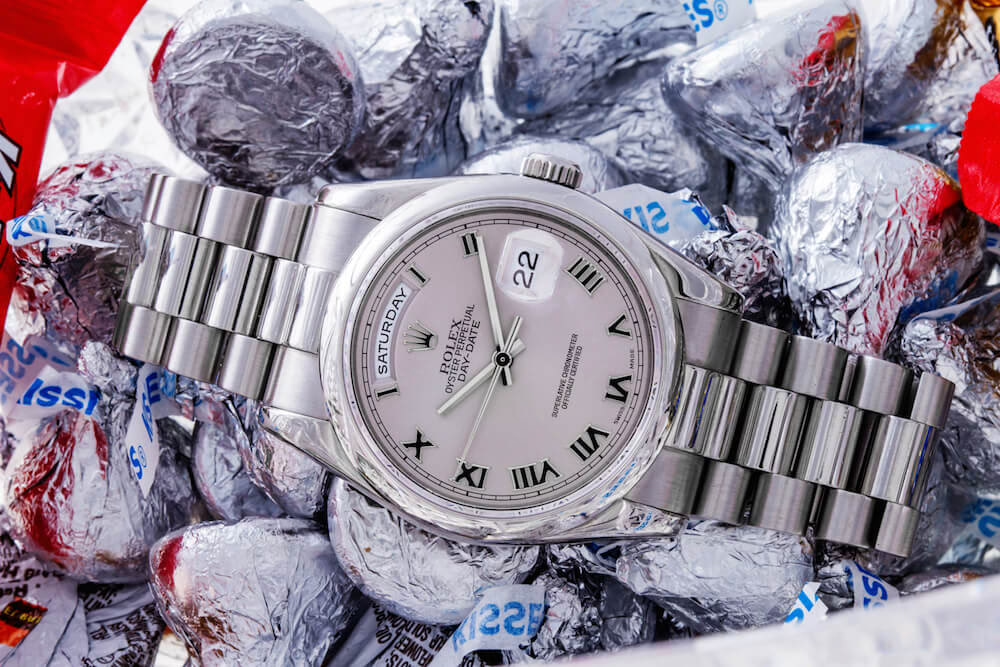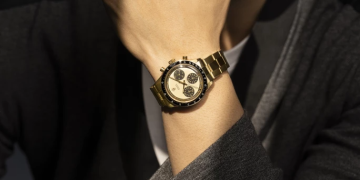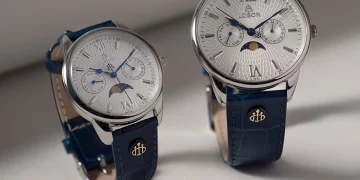The world of luxury watchmaking is one defined by precision, artistry, and a deep reverence for craftsmanship. Each component of a luxury timepiece, from the intricate movement to the polished case, is carefully chosen to ensure the watch is both functional and aesthetically exquisite. However, there is one metal that, despite once being considered an excellent choice for high-end watches, is now banned from many timepieces: Platinum 950. Once celebrated for its rarity and durability, platinum’s association with luxury and exclusivity has been tarnished by its inherent properties and controversial history.
In this article, we will explore the history of this once-revered metal in horology, the factors that led to its controversial ban, and whether it could make a comeback in the world of luxury timepieces. We will also examine the competing materials that have taken its place and whether platinum’s unique properties could one day overcome the obstacles that have kept it out of modern watchmaking.
The Rise of Platinum in Luxury Watches
Platinum has long been regarded as one of the most luxurious metals in the world. Known for its remarkable durability, rarity, and resistance to tarnishing, platinum was initially embraced by watchmakers as the material of choice for high-end timepieces. Its lustrous finish, which is more subtle and less reflective than gold or silver, quickly made it a preferred material for the cases of luxury watches, often in conjunction with precious gemstones and meticulous craftsmanship.
Platinum’s history in luxury timepieces dates back to the early 20th century. The metal was first used in watches in the 1920s, primarily by Swiss watchmaking houses such as Patek Philippe and Vacheron Constantin. Over time, platinum gained significant popularity in the industry due to its high density and its ability to resist scratching, making it ideal for creating robust and sophisticated watch cases.
In fact, some of the most iconic timepieces in history, such as the Patek Philippe Calatrava and the Vacheron Constantin Patrimony, were produced with platinum cases, further cementing the metal’s status as a symbol of prestige. This exclusivity helped to enhance the appeal of platinum watches, as they were seen as rare and precious, aligning perfectly with the values of craftsmanship and timeless elegance that luxury watches represent.
The Downside of Platinum: Challenges in Watchmaking
Despite its many advantages, platinum began to reveal some inherent challenges that made it less than ideal for use in high-end timepieces. One of the primary issues with platinum in watchmaking is its weight. While platinum is more durable and resistant to wear than other metals, its high density makes it extremely heavy. Watches made from platinum can feel cumbersome on the wrist, leading to a less comfortable wearing experience.
Furthermore, platinum’s high density can complicate the manufacturing process. The metal is more difficult to work with than gold or stainless steel, requiring specialized tools and techniques. It is more prone to distortion during machining, and the extreme hardness of the material makes it difficult to polish to the desired high finish. Many watchmakers found that the effort required to create platinum timepieces outweighed the benefits, leading some to look for alternative materials.
Another issue with platinum is its cost. As a rare and precious metal, platinum is significantly more expensive than gold, which makes it a challenging material to incorporate into mass-produced watches. This high cost often led to the decision to reserve platinum for only the most exclusive, high-end models. As a result, many luxury watchmakers found that they could achieve the same level of exclusivity and refinement with other materials that were more affordable and easier to work with.
The Controversial Ban of Platinum in Watchmaking
In recent decades, platinum’s use in luxury timepieces has significantly declined. Several factors have contributed to this ban, with the most significant being the metal’s inherent challenges in production and wearability. However, the ban wasn’t just a result of practical concerns; it was also linked to the growing trend of using lighter and more innovative materials that are more versatile and easier to manufacture.
The Challenge of Machining Platinum
Platinum’s hardness and density make it incredibly difficult to machine. Watchmakers who were accustomed to working with materials like gold or stainless steel found themselves grappling with the unique properties of platinum. Unlike gold, which is relatively soft and easy to manipulate, platinum requires special tools and techniques to handle and shape.
Moreover, platinum is prone to a phenomenon known as cold welding, where the material sticks to the tools being used to shape it. This makes the machining process frustrating and time-consuming, further contributing to its exclusion from many luxury timepieces. Watchmakers, particularly those working in large-scale production, began to turn away from platinum in favor of more manageable metals that offered similar durability without the labor-intensive work.
The Weight Factor
While the dense nature of platinum gives it significant durability, it also makes it heavy. A platinum watch can feel substantially heavier than one made of stainless steel or gold, leading to discomfort for some wearers. This weight factor was a major deterrent for many luxury watch enthusiasts, who preferred the lighter feel of other materials.
As watchmakers increasingly prioritized comfort and wearability in their designs, platinum’s weight became a major drawback. Consumers, particularly those who wore watches for extended periods, began to gravitate toward materials that offered a more balanced and comfortable wearing experience. As a result, platinum’s heavy weight made it less desirable for daily use.

Competing Materials: The Rise of Titanium and Ceramic
As platinum began to fall out of favor in watchmaking, alternative materials gained popularity. Two materials that rose to prominence were titanium and ceramic, both of which offered advantages over platinum while still maintaining the durability and aesthetic appeal that luxury watchmakers sought.
Titanium: Strength and Lightness
Titanium, which is much lighter than platinum, became a popular alternative for high-end timepieces. Renowned for its strength and corrosion resistance, titanium offered a perfect balance of durability and comfort. While it lacks the luster of platinum, titanium’s matte finish provides a sleek, modern look that has been embraced by watchmakers such as Omega, IWC, and Bremont.
Titanium’s resistance to scratches and its low weight made it an attractive option for those seeking a durable yet comfortable watch. As a result, many watchmakers adopted titanium for sports watches, limited-edition models, and professional-grade timepieces.
Ceramic: Innovation in Watchmaking
Ceramic, a material originally used in the production of watch bezels, has increasingly been used for entire watch cases. Ceramic is lightweight, extremely scratch-resistant, and offers a high-tech aesthetic that appeals to modern watch enthusiasts. It also comes in a range of colors and finishes, making it a versatile material for creative designs.
Brands like Rado and Hublot have been pioneers in the use of ceramic, incorporating it into their collections to create futuristic, durable, and comfortable timepieces. Ceramic’s smooth surface and resistance to wear and tear make it an appealing alternative to platinum, particularly for modern sports and luxury watches.
The Future of Platinum in Watchmaking
Despite the challenges and the decline in its use, platinum has not been entirely eradicated from the watchmaking world. Some brands still produce limited-edition platinum models, and the metal continues to hold appeal for collectors and connoisseurs who value its rarity and exclusivity.
There is also the possibility that platinum could make a comeback in the future, particularly as watchmakers explore new technologies and manufacturing techniques that could mitigate some of the material’s downsides. Advancements in 3D printing and laser cutting could make the machining of platinum easier, and new alloys and coatings could address issues related to the metal’s weight and wearability.
Conclusion: Will Platinum Return to Luxury Watches?
The controversial decline of platinum in luxury watchmaking can be attributed to a combination of practical challenges and evolving consumer preferences. While the metal’s rarity, durability, and aesthetic appeal made it a natural choice for high-end timepieces, its weight, machining difficulties, and high cost ultimately led to its exclusion from many modern luxury watches.
However, platinum’s history in horology remains rich, and the material still holds a special place in the hearts of collectors and watch enthusiasts. While it may never fully replace more modern materials like titanium and ceramic, platinum could make a return if new technologies and techniques are developed to overcome its drawbacks.
As the world of watchmaking continues to innovate, it is likely that platinum will remain a niche material, prized for its exclusivity and history, but with its place in luxury timepieces becoming ever more limited.












































